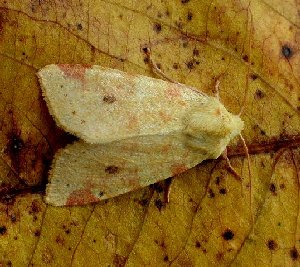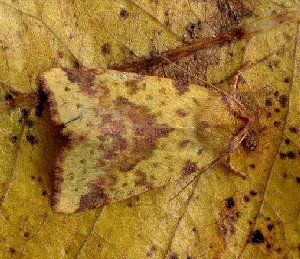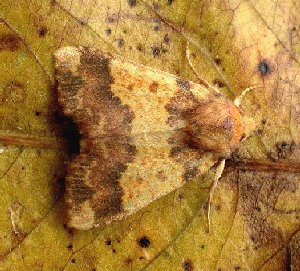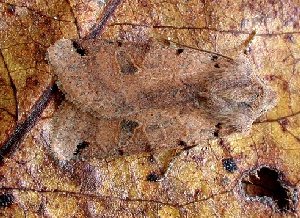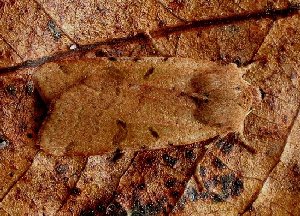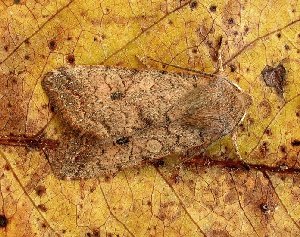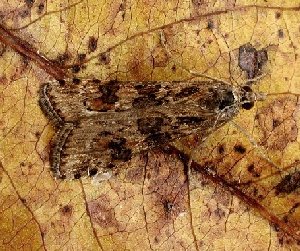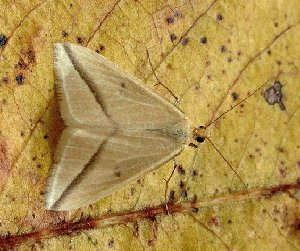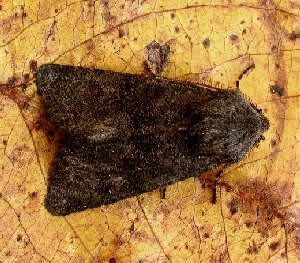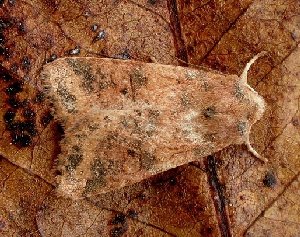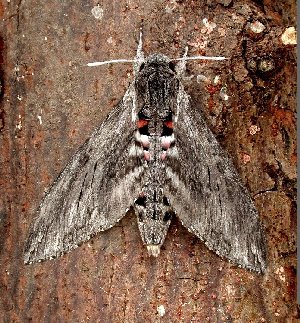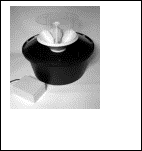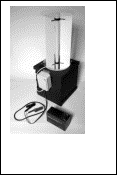Field
reports - Tony Prichard
1st July 2006 - Moth Night at Hinderclay Fen
With just Steve Woolnough and myself out on this evening we decided to
head for Hinderclay Fen.The three traps we had out covered most of the
main habitats of the site - heathland, scrub and fen. With the
favourable
weather the traps we had out produced a good selection of species for
the site, especially considering that we closed up not long after
midnight.
One of the more interesting species recorded was the Blackneck - a moth
I would more normally associate with the coastal and Breck areas of the
county. Older records exist for various areas of mid-Suffolk but
recently it has only been recorded in Bradfield, by Rafe Eley, in
mid-Suffolk.
Other species of interest recorded, out of a total of 133, where Dark
Spinach, Blue-bordered Carpet, Small Seraphim, Lobster Moth,
Marbled Brown, Short-cloaked Moth, Tawny Shears, White-point, Bird's
Wing, Small Clouded Brindle, Large Nutmeg, Double Lobed, Silky
Wainscot, Bordered Straw, Cream-bordered Green Pea, Scarce
Silver-lines, Pinion-streaked Snout. Micro-lepidoptera of interest
included
Morophaga choragella,
Monopis obviella,
Ethmia dodecea,
Phtheochroa
inopiana,
Calamatropha
paludella,
Platytes cerussella
and
Phlyctaenia perlucidalis.
7th July 2006 - Moth Night at Lackford Lakes SWT Reserve
The weather conditions on the night of this meeting did not appear
initially very favourable and I was not hopeful of a productive
evening. Six lights were operated along the tracks not too far
from the visitor centre, covering areas of wet woodland, scrub areas
and along some of the tracks.
A species I was not particularly expecting to see was Pempeliella
dilutella. The larva feeds on thyme and I wasn't aware that there was
much f the foodplant in the area, although we have recorded this
species before a short distance to the north in King's Forest where I
know the foodplant does occur.
Although publicised as an SWT event there had been very limited
interest, however we were joined by one person who had just turned up
for the evening without booking. A good selection of hawk-moths and
some of the more colourful moths obliged by making an appearance at the
lights, so it was a shame more people had not come along for the
evening.
In all 162 species were recorded and my premonition of a poor night was
completely wrong. Micro-lepidoptera of interest included
Yponomeuta evonymella,
Ethmia dodecea,
Brachmia blandella,
Phtheochroa
inopiana,
Cochylidia
implicitana,
Apotomis
semifasciana,
Calamatropha
paludella,
Platytes alpinella,
Phlyctaenia perlucidalis and
Pempelia
formosa. Macros of note were Small Seraphim, White Satin,
Short-cloaked Moth, Grey Arches,
Suspected, Coronet, Dingy Shears, Large Nutmeg, Slender Brindle, Double
Lobed, Cream-bordered Green Pea, Nut-tree Tussock and Dotted Fan-foot.
14th July 2006 - Moth Night at Lineage Wood
A meeting intended to look primarily for Brown Scallop and Dark Umber
that was rather foiled by a change of lock on the gate and a cold
night. Making the most of the situation we decided to run our lights at
the top end of the wood - not too far to carry the equipment. Good
numbers of Small Dotted Buff were probably the highlight of the evening
and despite feeling as though we were sitting in a wood in winter we
did manage to record 111 species. Species of note included
Helcystogramma rufescens,
Epinotia brunnichana,
Cydia fagiglanda,
Phlyctaenia perlucidalis,
Lackey, Least Carpet, Phoenix, Fern, Pretty
Chalk Carpet, Haworth's Pug, Brown-tail, White Satin and Slender
Brindle.
15th July 2006 - Moth Night at Cavenham Heath
Most of our visits to this nature reserve this year have been plagued
by rather indifferent weather. With a bunch of kids larking around and
lighting fires in the area where I had originally intended to
concentrate our recording we had a quick re-plan and ended up setting
up in the birch woodland on the southern edge of the heath. In the main
a rather slow night with nothing too unexpected recorded, although the
pick of the bunch were
Scythropia
crataegella,
Brachmia
blandella,
Epinotia
brunnichana,
Rhopobota naevana, Lackey,
Narrow-winged
Pug, White-line Dart, Archer's Dart, True Lover's Knot, Short-cloaked
Moth, Nut-tree Tussock. The moth of the night was singleton, presumed
migrant, plume moth - Cnaemidophorus rhododactyla. The larva feeds in
spun shoots of dog-rose - not much of that in the area where we were
recording. It is not a species that appears to be resident in Suffolk
so I would presume that this individual was a migrant.
21st July 2006 - Moth Night at Aldeburgh
This was quite a popular event with a group coming along from
Waldringfield and others from further afield in Essex. Fortunately Mark
Nowers, from the RSPB, was at hand and did a sterling job during the
evening of answering questions and showing around the boxed up moths.
As usual we were set up by the derelict cottage but the really
productive traps proved to be those out on the track cutting across the
North Warren RSPB reserve. The target of the evening was White-mantled
Wainscot, we had recorded a singleton the previous year and were hoping
to pick up some further individuals. This would hopefully give us a
better idea of whether tthe species was resident in the immediate area.
The traps out on the track soon became rather full with moths, clouds
of moth scales drifting up from the traps and visible in the moth
lights. Not too suprisingly there were good numbers of the various
yellow underwing species present, jostling around and disturbing the
other moths. Although the total species count of 160 species was not
exceptional this was one of those evenings were there large numbers of
moths filling the traps and there was lots of coughing and spluttering
as we went through the traps, as people inhaled the scales and various
midge-flies.
For the site nothing too unusual was recorded, although we did manage
to record a further singleton White-mantled Wainscot. Just having a
further singleton record did not really help us conclude whether the
species was present in the area or not. A further trip next year
is likely to see if we can do better. A notable migrant record was a
singleton Golden Twin-spot.
Other species of interest included
Yponomeuta
evonymella,
Ypsolopha
scabrella,
Eulamprotes
wilkella,
Anarsia spartiella,
Hedya ochroleucana,
Epinotia cruciana,
Epiblema
foenella,
Sitochroa palealis,
Pima boisduvaliella,
Euzophera cinerosella,
Oxyptilus distans,
Marasmarcha lunaedactyla, Oak
Eggar, Drinker, Tawny Wave, Small Seraphim, Brown-tail, Garden Tiger,
Kent Black Arches, True Lover's Knot, Dog's Tooth, Campion, Miller,
Dusky Brocade, Wormwood, Reed Dagger, Small Dotted Buff, Crescent,
Blackneck, Small Rufous, Bordered Straw and
Cream-bordered Green Pea.
22nd July 2006 - Moth Night at Shingle Street
A further night when just Steve Woolnough and myself were allowed out
to play with the moths. There were prospects for a good night
when we set off but the clouds were gathering when we arrived at this
private site and it was not long before the drizzle started. The
drizzle lasted for most of the evening and gave a generally damp
feeling to the evening. With just three traps 127 species were
recorded - nothing exceptional for the site but species of interest
included
Brachmia blandella,
Evergestis extimalis,
Melissoblaptes zelleri,
Pima
boisduvaliella,
Agdisits
bennetii,
Oxyptilus distans,
Ground Lackey,
Kent Black Arches, Star-wort, Double Lobed and Herald.
28th July 2006 - Moth Night at Hinderclay Fen
A further visit to this local nature reserve, particularly memorable
for the thousands of
Acentria
ephemeralla attracted to the lights. The ground around the sheet
appeared to be moving as the large numbers of
ephemerella fluttered around
amongst the grass. A reasonable count of 142 species were recorded from
five lights, with some giving an idea of the variety of habitats
available - these included
Monopis
weaverella,
Anacampsis
blattariella,
Scoparia
basistrigalis,
Eudonia truncicolella,
Nymphula stagnata,
Evergestis pallidata, Slender Pug,
Sharp-angled Peacock, Bordered Beauty, Maple Prominent,
White Satin, Garden Tiger, White-line Dart, Double Lobed, Mere
Wainscot, Twin-spotted Wainscot, Brown-veined Wainscot, Small
Rufous, Cream-bordered Green Pea, Oak Nycteoline. We also recorded a
migrant Small Mottled Willow
29th July 2006 - Moth Night at Tunstall Common
On previous visits to this site we had been a bit plagued by rain - it
could be dry elsewhere in the county but would be raining heavily on
Tunstall Common. This time we avoided any rain and had a rather
successful night with six lights operating. Not surprisingly most of
the species reflected the heathland habitat of the site but some were
obvious wanderers with Twin-spotted Wainscot,
Calamatropha
paludella,
Nymphula stagnata
and
Agdistis bennetii. I also
would not be surprised if the Lackey recorded was also a wanderer. A
couple of migrants recorded were Dark Sword-grass and Small Mottled
Willow. Other species of note from the list of 166 species were
Opostega salaciella,
Tinea trinotella,
Aspilapteryx tringipennella,
Ypsolopha scabrella,
Metzneria lappella,
Aristotelia ericinella,
Anacampsis blattariella,
Brachmia blandella,
Metendothenia
atropunctana,
Endothenia
ericetana,
Clavigesta purdeyi,
Eudonia truncicolella, Tawny
Wave, Small Scallop, Dark Spinach, Magpie, Sharp-angled
Peacock, Peacock Moth, White-line Dart, White-point and
Miller.
4th August 2006 - Moth Night at Hen Reed-beds SWT Reserve
The month of August saw the start of a series of rather poor moth group
nights - as we were plagued by poor weather at the weekends. This
evening was a particularly cold night and rather surprising for an
August night. A meagre 52 species were recorded from four lights in
both parts of the reserve and I would expect the site to do much better
than this given favourable conditions. We failed to record our target
species of White-mantled Wainscot (not too surprisingly) but
fortunately Tim Freed who had been visiting the county prior to our
visit had managed to pick the species up. The few species of note out
of the total of 52 included Eucosma obumbratana, Sharp-angled Peacock,
Dog's tooth, Reed Dagger,
Crescent Striped, Crescent and Twin-spotted Wainscot.
11th August - Moth Night at St Olaves
This moth night was cancelled due to poor weather.
16th August 2006 - Moth Night at Kessingland
A visit to the local parish nature reserve and fishing lakes well known
to the birding fraternity (I gather). There has been a bit of an
unsuccessful push by local naturalists to make the nearby reed-bed an
SSSI and it is hoped that the Fenn's Wainscot that we recorded on the
night may help the case. The local nature reserve and fishing lakes
overlook the reed-bed and lights placed on the boundary of the reed-bed
were well placed to shine out over the reed-bed. The appearance of the
plume moth,
Oidaematophorus
lithodactyla, given the amount of Common Fleabane around the
sheet light should not have been too much of a surprise. Other species
of note from the 79 species recorded were
Eupoecilia angustana,
Epiphyas postvittana,
Eucosma obumbratana,
Schoenobius gigantella,
Udea ferrugalis,
Magpie, Latticed Heath, White-point, Reed Dagger, Twin-spotted
Wainscot, Brown-veined Wainscot and Gold Spot.
18th August 2006 - Moth Night at Cavenham Heath
A rather poor night at this Breckland heath site due to low
temperatures. A rather low species count for mid-August of 53 species
give some idea of how poor it was. The best species of the night was
Marbled Clover, although other species worth mentioning were Hypatima
rhomboidella, Six-striped Rustic and Hedge Rustic.
25th August 2006 - Moth Night at Trimley Marshes SWT Reserve
A wet and rather frustrating night at this reserve. The upside was that
we could watch the sheet light from the comfort and dry of the visitor
centre. The frustrating part was that the moth lights were particularly
ineffective at attracting moths. Numbers of moths were seeing flying
amongst the reed-banks next to the sheet light but failed to be
attracted to the light. This I suspect was due to the close proximity
of the light from the extension to Felixstowe Docks - the moths
appeared to have lost their attraction to light. The best of the 40
species recorded were
Cochylis
hybridella,
Schoenobius
gigantella,
Agdistis bennetii
and
White-point. I mustn't forget the migrant pyralid
Ancylis oblitella that was also
recorded on the night.
26th August 2006 - Moth Night at Tunstall Common
A further visit to this heathland site and yet again we were not rained
out during the middle of the evening. Results were not as good as our
previous visit but still provided a reasonable list of 73 species, with
the more notable including
Cochylidia
implicitana,
Celypha rosaceana,
Crambus hamella,
Pyrausta
despicata,
Cryptoblabes
bistriga,
Dioryctria
sylvestrella, Satin Wave,
Hedge Rustic, Feathered Gothic, White-point, Centre-barred Sallow and
Scarce Bordered Straw.
Reports
from Recorders around the county
Records reported in
this section have not been checked by the Suffolk Moth Panel. Many
thanks go to the recorders who provide write-ups and records for this
section.
Mendlesham Green, July to October -
Steve Woolnough
As we all know, in marked contrast to the earlier part of the year,
July was a scorcher, and moth records for the garden responded in a
similar record-breaking manner. Two days saw records of over 100
species, and the total for the month was 220, the highest monthly total
since I began recording here.
The first ‘bumper’ night was on 5th July, with a catch of 107. Of
these, no less than nine were new records (
Eana incanana,
Endothenia gentianaeana,
Lobesia abscisana, Peach Blossom,
Pretty Chalk Carpet, Maple Prominent, Bird's Wing, Small Dotted Buff
and Clouded-bordered Brindle). There was also 9 Buff Arches, which is
one of my favourite moths in terms of pure aesthetic charm, and in
excess of 40 Flame. Scarce Silver-lines and Green Silver-lines provided
an attractive comparison.
Total species numbers in the high 80’s and 90’s continued through the
month, with the next count in excess of 100 occurring on 25th July,
when 105 were recorded with
Perinephela
lancealis, Lesser Wax Moth, Slender Pug and Reed Dagger all
being new. There was also three Rush Veneer, seven Poplar Hawks and a
Least Carpet. The night was also significant for the ‘One that Got
Away’…
Going through the trap the following morning, I saw a Least Black
Arches. I was not overly familiar with the species, but I had had them
in the trap before, and this had the two black cross-lines with the top
one fainter than the bottom one, and a small dark spot on the leading
edge of the forewing. After about 30 seconds, it flew from the
egg-tray, but I was not particularly concerned, being content with my
identification. It was only later that morning when checking my books
that I realised the flight time was completely wrong for Least, and
from my memory of the moth, the description matched that of Scarce
Black Arches. Once again, the maxim of a little knowledge being a
dangerous thing appeared to have been proven.
Other new garden records for the month were
Endothenia quadrimaculana (11th),
Gypsonoma sociana,
Eudonia truncicolella,
Evergestis pallidata,
Platyptilia gonodactyla and
Beautiful Carpet (all on 18th),
Perinephela
lancealis, Slender Pug and Peacock (25th),
Agonopterix ocellana, Birch Mocha
and White-spotted Pug (28th). A total of 24 new species for the garden
in the one month!
Other notable July records were the 10 Privet Hawks in the trap on 11
July and some 40 Silver Y on 28th July.
Of course, it could not last, and August brought rain, rain and more
rain. Consequently, the trap was run on only four nights, with a peak
count of only 59 species on 5th, and just two new species recorded,
with
Ypsolopha vittella and
Cochylis hybridella both appearing
on 27th. A miserable 95 species was recorded, the lowest monthly total
for August since I started trapping. The month was chiefly notable for
seeing a Hummingbird Hawk-moth nectaring on the buddleias and
honeysuckles on almost every day, even during quite heavy rain. The
only other records of comment were three Dark Sword-grass on 27th and a
Bordered Straw on 19th.
The trend was continued for September, with just 60 species, again the
lowest number for the month I’ve ever had, and with no new garden
records. Similarly, October, too, had the lowest ever total for that
month with just 21 species, although
Udea
ferrugalis and Grey Shoulder-knot both on 13th were new to the
garden. A Meal Moth was found in the shed on 22nd, and the final Silver
Y of the year appeared on 27th.
In summary, apart from July, it has been a poor year. A total of just
304 species recorded from only 43 trapping nights, compared to annual
averages of 364 species from 80 nights prior to this year, tends to
tell its own story of how disappointing the weather, and hence the
mothing, has been for 2006.
Redisham, July to September 2006 -
Bob Reed
Bob Reed recording in Redisham reports the following species for July
to September this year -
Parapoynx
stratiotata,
Pleuroptya
ruralis,
Hypsopygia costalis,
Chinese
Character, Buff Arches, Blood-vein, Small Fan-footed Wave, Riband Wave,
Common Carpet, Barred Straw, Lime-speck Pug, Magpie Moth, Clouded
Border, Brimstone Moth, Dusky Thorn, Early Thorn, Scalloped Oak,
Swallow-tailed Moth, Orange Moth, Peppered Moth, Clouded Silver, Light
Emerald, Privet Hawk-moth, Pine Hawk-moth, Lime Hawk-moth, Eyed
Hawk-moth, Poplar Hawk-moth, Humming-bird Hawk-moth, Elephant
Hawk-moth, Buff-tip, Iron Prominent, Swallow Prominent, Pale Prominent,
Yellow-tail, Black Arches, Dingy Footman, Common Footman, Ruby Tiger,
Heart and Club, Heart and Dart, Flame, Flame Shoulder, Large Yellow
Underwing, Lesser Yellow Underwing, Broad-bordered Yellow Underwing,
Lesser Broad-bordered Yellow Underwing, Small Square-spot, Setaceous
Hebrew Character, Double Square-spot, Cabbage Moth, Dot Moth,
Bright-line Brown-eye, Lychnis, Hebrew Character, Brown-line
Bright-eye, Clay, White-point,
Smoky Wainscot, Common Wainscot, Brindled Green, Centre-barred Sallow,
Lunar Underwing, Sallow, Poplar Grey, Sycamore, Grey Dagger, Copper
Underwing, Angle Shades, Dark Arches, Light Arches, Marbled Minor,
Common Rustic, Uncertain, Rustic, Green Silver-lines, Burnished Brass,
Silver Y, Plain Golden Y, Spectacle, Red Underwing,
Beautiful Hook-tip, Straw Dot, Snout and Fan-foot.
Bungay, Summer and Autumn 2006 - Leigh
Davis
Although not able to do much recording in late summer and autumn, Leigh
Davis recording in Bungay reports the following species for the summer
and autumn months -
Chrysoteuchia
culmella,
Elophila nymphaeata,
Parapoynx stratiotata,
Nymphula stagnata,
Phlyctaenia coronata,
Pleuroptya ruralis,
Endotricha flammealis, Drinker
Moth, Blood-vein, Small Blood-vein, Single-dotted Wave, Riband Wave,
Silver-ground Carpet, Yellow Shell, Barred Straw, Barred Yellow, Small
Rivulet, Scorched Carpet, Scalloped Oak, Swallow-tailed Moth, Willow
Beauty, Bordered White, Light Emerald, Iron Prominent, Vapourer Common
Footman, Lesser Yellow Underwing, Broad-bordered Yellow Underwing,
Lesser Broad-bordered Yellow Underwing, Setaceous Hebrew Character,
Cabbage Moth, Dot Moth, Brown-line Bright Eye, Smoky Wainscot, Dark
Arches, Double Lobed and Vine's Rustic.
Eye Moths, July to October 2006 - Paul
Kitchener
July
From famine to feast is probably the only way to describe the amazing
change in moth numbers from the first six months of the year. The long
hot spell produced many first records for the garden and many species
had their best year out of the five that I’ve been recording here.
The month got off to a good start and just got better, the 123 species
on the 1st included first site records for
Acrocercops brongniardella and
Phtheochroa inopiana (eight more of
the latter were seen before the month’s end). Also that night were
Epermenia chaerophyllella (eight
this year having been recorded for the first time only last year),
Ancylis achatana (three),
Schoenobius gigantella (two),
Ostrinia nubilalis (the first of
three this month),
Phlyctaenia
perlucidalis (five),
Sciota
adelphella (two; eight in all this year), Peach Blossom,
Blue-bordered Carpet, Small Yellow Wave (two), Maple Prominent, Dingy
Shears (two), Clouded Brindle and Double Lobed.
The 15W actinic was put out for a change on the 2nd and turned up the
first site record for Silky Wainscot, two more
Sciota adelphella and only the
second site record for
Scoparia
subfusca.
The other first site records in a very busy month were for
Cedestis gysseleniella on the 4th,
Dichrorampha vancouverana (the
first of two) and Rosy Footman on the 5th, Ruddy Carpet on the 8th,
Marasmarcha lunaedactyla on the
9th,
Monochroa lucidella on
the 10th (with two more later in the month),
Dichrorampha petiverella and Large
Emerald (a second just a week later) on the 12th,
Epinotia abbreviana on the 17th,
Stathmopoda pedella (the first of
two),
Limnaecia phragmitella
(the first of five),
Argyrotaenia
ljungiana,
Acleris kochiella
and Dotted Fan-foot all on the 19th, Rosy Minor (surprisingly a first)
on the 20th, Birch Mocha (another a week later) on the 21st,
Apotomis lineana (the first of five
in a couple of weeks) and
Platytes
alpinella on the 22nd,
Epinotia
brunnichana and Yarrow Pug on the 23rd,
Endothenia ericetana (the first of
two) and
Pima boisduvaliella
(probably the biggest surprise of the month, this pyralid apparently
being restricted to the coast) on the 26th and
Agriphila selasella (the first of
four),
Sitochroa palealis and
Small Mottled Willow (the first of ten) on the 27th.

|
 |
Cedestis
gysseleniella © Paul Kitchener
|
Monochroa
lucidella © Paul Kitchener
|
The night of the 19th was a record breaker, not just for producing five
garden firsts, but for the total of 142 species. Apart from the new
ones already mentioned this total included twenty
Plutella xylostella (it has easily
been the best year for this species),
Monochroa
palustrella (eight this year),
Chilo
phragmitella (one of four this month and the first since 2003),
Calamotropha paludella,
Nephopterix angustella (it has been
the best year for this pyralid with a total of twenty four compared to
the previous best of ten), Least Carpet (one of the nine seen this
year, having been seen for the first time in 2004), Dark Umber (fourth
garden record), Bordered Beauty (five recorded this year, none at all
in 2005), Orange Moth (one of three this month), Olive (of nine this
year, none last year), six Dingy Shears (best year since 2003), two Fen
Wainscots (a total of ten this month after one previous record, last
year), three Scarce Silver-lines (of eight this year, only four being
seen over previous four years) and an Oak Nycteoline.

|
Olive © Paul Kitchener
|
Some of the other notable species/numbers this month were eight Leopard
Moth, two
Plutella porrectella
(fifth and sixth records), two
Orthotelia
sparganella (second and third records),
Acleris hastiana, three
Hedya salicella,
Clavigesta purdeyi (sixth record),
six
Enarmonia formosana, very
good numbers of
Pammene aurita
and
regiana (the year totals
were, by far, the best ever, 136 and 224 respectively), eight
Nomophila noctuella (the year total
is the best since 2003), exceptional numbers of
Pleuroptya ruralis (over two
hundred trapped on several nights), second site record of
Aglossa pinguinalis,
Amblyptilia acanthadactyla (seven
recorded this year, only two previously), Vestal (second record, on the
30th), Scallop Shell (fourth record), sixteen White Satin, Black Arches
(only the second garden record, the first in 2001), Four-dotted Footman
(second record), Dark Sword-grass (the first of the year on the 30th),
True Lover’s Knot (third record), three Gothic (I have never trapped
more than one in a year before), two Dark Brocade, two Small Rufous
(second and third records), up to thirty Silver Y a night (it has had
the best ever year at this site), Buttoned Snout (my first July record)
and Pinion-streaked Snout (third record).

|

|
Plutella
porrectella © Paul Kitchener
|
Orthotelia
sparganella © Paul Kitchener
|
Many species were more numerous this year, the following are just some
of them (that occurred this month) and for those of you who are
interested, if there is anyone, I’ve included their totals for this and
the preceding four years (2002 -2006).
Yponomeuta evonymella
(0/61/8/8/72),
Phlyctaenia
perlucidalis (1/7/9/12/24), Riband Wave (119/216/266/150/441),
Eyed Hawk-moth (1/3/1/3/10), Common Footman (76/204/201/240/528),
Turnip (4/41/27/44/360), Heart and Club (1/10/0/2/18), Flame Shoulder
(796/1923/299/729/2024), Lesser Yellow Underwing (86/119/198/176/486),
Broad-bordered Yellow Underwing (11/30/15/32/95), Setaceous Hebrew
Character (606/2985/505/468/4098), Cabbage (39/380/7/37/373), Common
Wainscot (80/382/75/113/610), Angle Shades (28/90/17/43/100), Dark
Arches (57/94/151/121/214), Common Rustic (252/336/246/380/610), Vine’s
Rustic (18/130/128/71/611), Pale Mottled Willow (57/130/59/86/296),
Cream-bordered Green Pea (11/23/18/25/34), Straw Dot
(102/262/116/144/440) and Snout (67/179/109/297/468).
August
The media hype of an even hotter month to come proved to be nothing
more than that and although it had it’s moments August was never going
to match July for prolonged mothing excitement.
Six new species were recorded: Twin-spotted Wainscot on the 8th,
Adoxophyes orana on the 11th,
Acleris laterana (a second the next
day) and Bordered Straw on the 17th, Crescent (a second four days
later) on the 18th and a Scarce Bordered Straw (others to follow in
September and October) on the 26th.

|
Twin-spotted Wainscot © Paul Kitchener
|
The night of the 6th August was one of the warmest and was probably one
of the better nights in terms of variety with
Yponomeuta plumbella (the only one
of the year),
Apotomis lineana
(the last one of the five this year),
Chilo
phragmitella,
Calamotropha
paludella,
Agriphila selasella
(two),
Udea ferrugalis (two),
Nomophila noctuella,
Nephopterix angustella (four), Oak
Hook-tip (still an uncommon moth here though apparently on the
increase), Currant Pug (two, of the fourteen this year, the most ever),
Yellow-barred Brindle, White-line Dart (only the second record, the
first in 2003), Dark Sword-grass, White-point (the first of the
“autumn”) and Silver Y (eight).

|
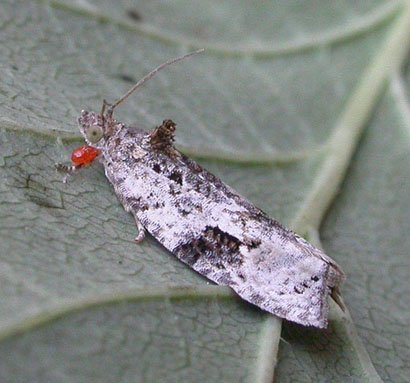
|
Scarce Bordered Straw © Paul Kitchener
|
Apotomis
lineana with red mite © Paul Kitchener
|
The best of the rest, for these parts, included
Ypsolopha sequella (fifth record),
a total of ten
Udea ferrugalis
(there were only two in the whole of last year), eight
Nomophila noctuella (only one last
year),
Galleria mellonella
(one of three this year; there had been only two in the previous four
years),
Amblyptilia acanthadactyla
(six), Small Waved Umber (the last of the best ever seven this year),
Dark Sword-grass (ten this month, only two last year), White-point
(maximum of thirteen on the 17th), Old Lady (second site record on the
24th, to MV), Straw Underwing (an uncommon moth here, only one this
year, as in 2005), Bulrush Wainscot (sixth and seventh records), Small
Mottled Willow (five this month between the 8th and 13th) and Dark
Spectacle.
Of the more frequently occurring moths seen this month the following
appear to have had a very good year (numbers are ‘02 -’06):
Clepsis consimilana
(4/64/43/78/203),
Ditula angustiorana
(14/39/51/33/230),
Hypsopygia
costalis (50/76/53/61/180),
Orthopygia
glaucinalis (2/0/9/8/20), Small Dusty Wave (17/21/25/38/98),
Small Square-spot (223/48/7/24/292) and Six-striped Rustic
(7/26/19/39/140).
Strangely Flounced Rustic remains uncommon here although it’s fortunes
may be on the up as this year’s total of twenty is better than the six
last year and also above average for the last six years. Not many
species have had an obvious poor year but mention must be made of the
carpets Common, Garden and Green which have all appeared in their
lowest numbers for four years.
Of the “autumn” moths Dusky Thorn first appeared over a week later than
usual, but it may now be holding it’s own after a slide in numbers over
the previous ten years (at my two trap sites in Eye). The numbers for
this and the previous two years have been much the same so things look
hopeful.
September
The month was notable for it’s very mild nights, only on five occasions
did the minimum temperature drop to single figures and on ten nights
the minimum was 15° C or above.
Only one new species was recorded however,
Calybites phasianipennella on the
25th, but it nevertheless was a very interesting month in which several
species were still on the wing on their latest dates ever recorded.
Some of these were
Prays fraxinella
on the 12th and 17th,
Brachmia
blandella on the 22nd, six
Archips podana (I have recorded it once in October),
Enarmonia formosana on the 26th,
Phlyctaenia coronata on the 23rd,
Galleria mellonella on the 5th,
Nephopterix angustella on the 20th,
Maiden’s Blush on the 23rd, Willow Beauty on the 30th, Eyed Hawk-moth
on the 1st and Heart and Dart on the 24th.
Light Emerald had an exceptional second generation, fifty two being
recorded between 15th August and 21st September and Mottled Rustic, a
species that is rarely seen beyond the end of July, was recorded eight
times (ten individuals) between 14th September and 11th October.
Other notable bits and pieces this month were
Ypsolopha sequella (sixth record so
soon after the fifth), only three
Plutella
xylostella, three
Epiphyas
postvittana (first recorded in May and by all accounts this will
probably be the last report in which I consider it’s occurrence as
notable),
Acleris emargana
(third record), only one
Udea
ferrugalis, nine
Nomophila
noctuella, six
Pyralis
farinalis (eighteen seen this year which equals the total for
the preceding four years),
Dioryctria
abietella (second record, the first was in 2001), four Dark
Sword-grass, fifty White-point (maximum fifteen on the 3rd), Feathered
Ranunculus (one of only two this year, this is still a scarce moth
around here, though it has been seen every year since 2002), four
Orange Sallow, Old Lady (third record and second this year, this one
also came to the MV), Small Mottled Willow (the last of the ten this
year on the 25th), three Scarce Bordered Straw (one, 6th and two,
24th), Oak Nycteoline (my first September record), Silver Y (no more
than three in a night however), seven Dark Spectacle (none were seen in
the summer at all, the ten this year have been between 30th August and
10th October) and three Red Underwing.
The regular late autumn species appeared pretty much on cue, though the
first Yellow-line Quaker was ten days earlier (17th) than my previous
earliest, Brown-spot Pinion (3rd) was eight days earlier and Beaded
Chestnut (7th) was ten days earlier. There was Mallow on the 16th,
Merveille du Jour on the 26th (sixteen being seen by the 27th October,
my best ever total at this site), Large Wainscot on the 24th (the
totals for this moth have increased year on year since 2002 -
1/2/9/17/45) and Blair’s Shoulder-knot also on the 24th (this also had
it’s best ever year at this site). One moth that remains inexplicably
scarce here is Brindled Green, two were trapped this year but it has
only been recorded in four years out of the last six and Frosted Orange
was seen in the lowest numbers since 2001.
October
The mild conditions continued with minimum night time temperatures
remaining in double figures for seventeen nights and winds were
predominantly from the south and east.
Four new species were recorded and not surprisingly, given the weather,
three of these were migrants. A Black Rustic on the 10th was one I had
expected to get at some time as was Pearly Underwing (singles on the
14th and 23rd). The latter I had recorded six times in five years at my
previous site in Eye so the gap of six years until the next was
surprising. The other two new species were far more unexpected. A Red
Sword-grass on the 16th was a moth I had always wanted to see (and has
to be my “moth of the year”) but a rather worn Clancy’s Rustic on the
20th was not quite so attractive but was just as welcome. Although it
has been the best year on record in Suffolk for this moth and it seems
to be on the increase nationally I thought my chances of getting one
here, 30 miles from the coast, were pretty slim.

|
Red Sword-grass © Paul Kitchener
|
The other migrants(?) this month have been
Plutella xylostella (ten),
Udea ferrugalis (eighteen, maximum
of four on the 26th),
Nomophila
noctuella (five between 14th and 23rd), Gem (the fifth to
seventh records on 9th, 10th and 20th), Dark Sword-grass on the 17th,
White-point on the 11th (the previous and probably “resident” one was
on the 23rd September), Scarce Bordered Straw (the fifth this year) on
the 14th and Silver Y (seven).
A year ago I reported that White-point was likely to be a local
resident and this year’s figures add further evidence. Since 2001 the
totals have been 1/0/8/5/46/150 and this year’s monthly totals are June
(2), August (97), September (50) and October (1). If I were getting
only migrants it seems odd that I didn’t see any at all in July, the
hottest month of the year when plenty of other stuff was on the move.
Given the exceptionally mild conditions the resident moths also
provided a few surprises this month and the following were all notable
October records:
Carcina quercana
(three, the last on the 28th),
Clepsis
consimilana (two, the last on the 10th),
Hypsopygia costalis on the 16th (I
have recorded it in Eye in November one year),
Orthopygia glaucinalis (regularly
seen in October but more this year, a maximum of four on the 9th),
Pyralis farinalis (first October
record on the 16th), Blood-vein (the most in October ever, maximum of
four on the 9th), Small Dusty Wave on the 14th, Brimstone on the 9th,
Waved Umber on the 20th, Dingy Footman (one of the form stramineola) on
the 10th and and 15th, Dark Spectacle (two, 1st and 10th) and Straw Dot
(seven records of ten individuals included the latest ever on the 20th).
More typical of October were
Acleris
emargana (fourth and fifth records), Red-green Carpet (third
record and third consecutive year), Vapourer, Grey Shoulder-knot,
Satellite and Brick. More Angle Shades were seen than usual and some at
least may have been migrants (five on the 14th accompanied the Pearly
Underwing and Scarce Bordered Straw).
A few moths are still about but the first frost of the autumn cannot be
long coming, especially here in Eye, so it will soon be time to return
indoors and reacquaint myself with the wife (if she‘s still about).
Post-Plusia Blues ... the autumn run-in
at
Woolpit - Paul Bryant
How was I going to follow the Plusia caught in mid June? Given that I
consider my garden to be anything but a prime migrant hot-spot the
answer would appear to be with difficulty. However, regular trapping
continued to produce surprises until at least month end. Amongst the
highlights were Lilac Beauty (singles on 16th & 23rd), female Ghost
Moth (16th & 29th), Broad-barred White (16th),
Phtheochroa rugosana (16th),
Shoulder-striped Wainscot (16th), Bordered White (17th), Shark (21st),
Varied Coronet (23rd), Small Clouded Brindle (24th) and Peach Blossom
(24th). Additionally, Ann found ‘a creature’ (her words not mine)
chomping away on our buddleia which turned out to be a Mullein
caterpillar. Amazingly, we found three more the following day. Just as
impressive, on the 26th June I found a White-point on my office window
at Flempton!

|

|
Lilac Beauty © Paul Bryant
|
Peach Blossom © Paul Bryant |
Early July was still busy with trap counts hovering around the 65sp
mark. Three Orange Moth, a Cream-bordered Green Pea, Lilac Beauty and
two Short-cloaked Moths were caught on the 1st. The next day there was
a Scarce Silver-lines and another rugosana. The 5th produced Scorched
Wing,
Orthopygia glaucinalis, yet
another female Ghost Moth (or is it the same one having a ground-hog
day?) and yet another Cream-bordered Green Pea. On the 11th I had
Herald, Bordered Pug, 2 Early Thorn and a Beautiful Golden Y.
Mid-July saw period of incredibly warm, often hot and humid weather,
with night time temperatures hovering around the mid-teens. Not
surprisingly a lot of people were catching a lot of moths. The night of
the 19th was particularly warm and, after returning from Shingle Street
where we had been sitting in jeans and t-shirt, I got home to find my
trap alive with flies, beetles and a motley selection of Underwing’s,
the most numerous of which were 30 Broad-bordered Yellow Underwings in
all there various shades from dark to light. Amongst the 70 odd species
noted were 2 Latticed Heath, a Magpie Moth, Lunar-spotted Pinion,
Poplar Kitten, Slender Brindle and a Beautiful China-mark. Just a few
days earlier I had notched up the first garden Olive and a Meal Moth.
The latter, no doubt attracted by the trap light, had somehow wandered
in through a bedroom window as I found it indoors the following
morning.
Late July saw me in Scotland where I was taking part in a Northern Dart
survey. Feeling a bit moth’d out it wasn’t until the 5th August that I
felt any inclination to run the garden trap. My reward was 37 species,
including 3 Silver Y, Coxcomb Prominent and a Rush Veneer. The
remainder of August continued on a cooler and fresher note. The garden
continued to produce reasonable catches, although little of any real
note until mid-month when I started picking up single White-point on
most trap nights. Other highlights included Bordered Pug (7th), Small
Waved Umber (10th), Lychnis (2 on 8th), Dusky Thorn (1 on 16th & 2
on 25th) and my first Rosy Rustic of the year (10th). I also started
paying a bit more attention to our buddleia, which by now was Mullein
free and in flower. Searching by torch light revealed several Silver Y,
Setaceous Hebrew Character, Nutmeg, Cabbage Moth and Vine's Rustic
amongst others. A much anticipated garden first was Humming-bird
Hawk-moth, first seen on the evening of the 22nd and then on-and-off
over much of the following week. Best of all however was a Pale Mottled
Willow, seen on the evening of the 28th. It kind of made me feel like
on of those old Victorian collectors, minus the gas lamp! I also tried
sugaring in the back garden, with less success, the only visitor seen
being an Old Lady (29th) which refused to have its photo taken.

|
Dusky Thorns © Paul Bryant
|
A week in France with Neil, Graham and Matthew in early September mean
that little trapping took place until 11th. I wasn’t expecting much but
was surprised to find a good selection of moths in the trap the
following morning. The major highlight was a Small Ranunculus (subject
to confirmation, the first VC26 record since 1898) and a Dusky-lemon
Sallow. That same night I also recorded 2 Pale Mottled Willow, a Dusky
Thorn (there was also 1 on 15th) and a Scarce-bordered Straw, which I
found the following morning in our bedroom whilst opening up the
curtains. The following week (16th) I added Buttoned Snout and Black
Rustic to garden list. Another Black Rustic appeared on 27th as well as
three more Scarce Bordered Straw (24th, 26th and 27th). The latter were
but a fraction of the hundreds that most have been around the country
as recorders seemed to be picking these up everywhere. Try as I might
though, I failed to attract a Convolvulus Hawk-moth to either the trap
or the nicotiana planted out front.

|

|
Small Ranunculus © Paul Bryant
|
Scarce Bordered Straw © Paul Bryant |
Other September highlights included Meal Moth (1st), Rush Veneer (5 on
odd dates though the month), Oak Hook-tip and White-point (both on the
12th) Frosted Orange (17th), Merveille du Jour (22nd), Mallow (23rd)
and Brown-spot Pinion (22nd & 30th). However, by the end of the
month things had a much more distinct autumnal feel with cooler nights
and damper mornings. Trap numbers have already started to decline quite
considerably and for the most part all I’m catching are a handful of
Lunar Underwings, Beaded Chestnuts and the odd Blair’s-shoulder Knot,
Yellow-line Quaker, Angle Shades or Sallow spp. But that’s one of the
great things about mothing; you just never quite know what will turn up
next!
As always, happy trapping.
Moths at Ipswich Golf Course, July to
September 2006 - Neil Sherman
July
July 2006 will be remembered as one of the best periods for moth
recording in many years. Hot, humid conditions dominated the month,
with daytime temperatures regularly over 30 degrees while at night it
stayed in the high teens/early twenties. Traps were run on 18 nights
during the month, trying many different areas of habitat around the
site as well as the garden and work shed areas. This produced a total
of 484 species (233 macros, 251 micros) for July, by far the best
species count for a month since recording began here in 1994. On most
nights, the average number of moth species trapped was 130+, but 2
nights stood out as being exceptional. On the 19th, with 2 traps
running on a heathland area, 220 species were recorded, beating the
previous best species count of 182 (set in 2004) by quite a long
margin! The following night, a single trap run in the garden caught 178
species, an incredible number considering we run up to 8 traps on most
SMG moth nights and rarely get above 150!
As it was such a good month, there was at lot of interest seen, not
just good species but large numbers of certain moths. I will try to
cover all of this the best I can, there’s a lot to write about!
Macros of possible interest included the following, starting with new
site records. L-Album wainscot was recorded on 2 occasions – on the 4th
and 6th, both times in the garden trap, possibly wanderers from the
coastal population. These were followed by a Triple-spotted Clay on the
16th – this was a species that was expected to turn up at some point.
Many Double Square-spot had been checked looking for it! The night of
the 20th produced 2 new macros – a Marbled Green (again another moth
from the coast) and more surprisingly a White-mantled Wainscot. Whether
this moth had wandered from one of the known populations or had come
from a more local unknown site is anyone’s guess. I did try trapping
reedbed areas around the site (as I have done many times before) after
this capture but no other records were forthcoming. Lastly, on the
23rd, a Langmaid’s Yellow Underwing was picked out from the numerous
Lesser Broad-bordered Yellow Underwings. A number of these moths had
turned up on the coast at around the same time. This record was only
confirmed once the moth was set, revealing the relevant features for
identification.

|

|
L-album Wainscot © Neil Sherman
|
Marbled Green © Neil Sherman
|
Other notable moths included Festoon (47 recorded during the
month). Blotched Emerald continued to fly at the start of the month,
with 3 on the 2nd and 2 on the 3rd, but none after this. 4 second brood
Birch Mocha were seen, after being non-existent earlier in the year.
There were 2 records of Tawny Wave, on the 27th and 28th. Least Carpet
had a good month with 39 noted, as did Flame Carpet with 5 records.
Chevron appeared twice (4 on 19th with another 25th). There were 9
records of Scallop Shell, this being a very good number here. Pugs seen
included Slender (12 records), White-spotted (2), Shaded (4th), Yarrow
(26th), and Sloe (2nd). The only record of Broom-tip for 2006 was on
the 19th. 4 Clouded Magpie were seen, mainly in the garden. This leads
me to believe there is a small breeding colony nearby. Scorched Carpet,
a scarce moth at the site, was seen twice (26th and 27th). The
Sharp-angled Peacock was noted 13 times, this must now be established –
it was even more common than the Peacock on a few nights. Both Bordered
Beauty (6 records), Early Thorn (5) and Purple Thorn (7) appeared in
good numbers, especially nice to see the thorns after their poor first
brood showing. Of the hawks, it is always good to get Privet. One
was seen in the garden trap on the 26th – this seems quite scarce at
the site for whatever reason. Commonest species was the Pine, with 42
noted, the best total for this species in a month. There has only been
1 Chocolate-tip so far in 2006, on the 17th. This again reflects on the
poor early season. The 2 White Satin seen on the 25th were only the
second and third records for the site so were greatly received. Its
relative, the Black Arches, was abundant with 136 noted in July. The
Kent Black Arches was also around in good numbers – 9 were recorded.
This leads me to believe that it may be established with regular
records in the last few years. There were records of Gothic on the 17th
and 25th (the second and third site records). Grey Arches appeared 4
times, good to see after a poor showing last year. The Mathew’s
Wainscot trapped on the 2nd was the second for the site, another
wanderer due to the warm weather. The only record of Svensson’s
Copper Underwing was on the 6th, a typical date. This species in my
experience does come out before the Copper at this site. Webb’s
Wainscot put on a good showing, with 6 seen on the 25th trapping in a
reedbed area with another on the 24th in the garden. Also seen in the
reedbed on the 25th was the second site record of Silky Wainscot. The
Small Rufous was seen a few days later in another wetland area, with 3
on the 27th. Continuing the wetland theme, there were 3 records of
Dotted Fan-foot. However, its relative the Shaded Fan-foot continued to
have a poor year with only 6 noted following on from the one seen in
June. Finally there were 4 Small Mottled Willows seen, showing some
immigration was occurring, with one on the 25th and 3 in the garden
trap on the 26th.
The number of micros seen during the month was enormous, so I’ll pick
out the notables for the site and list them below – there were too many
to cover in much detail! New site records included:
Agonopterix ciliella (19th,
confirmed once set so the 5 lines on the hindwing could be seen),
Carpatolechia alburnella (4
records),
Scrobipalpa instabilella
(2 on the 19th wandering in from the coast on a hot night),
Sciota adelphella (20th in the
garden trap),
Pima boisduvaliella
(2 on the 27th, again another coastal wanderer) and
Nephopterix angustella (2nd).
Others of note:
Leucoptera
spartifoliella (second record on the 9th),
Cameraria ohridella (34 seen during
the month, as well as loads of mining activity),
Yponomeuta rorrella (first since
2001 on 26th),
Zelleria hepariella
(second record 20th),
Thiotricha
subocellea (third record 25th after first 2 last year),
Blastobasis adustella (lignea)
(5195 noted, with 500+ on some nights – now IGC’s commonest moth),
Blastodacna hellerella (3rd, new
only last month),
Dystebenna
stephensi (17th, second record),
Bactra furfurana (27th, second
record),
Ostrinia nubilalis
(4),
Trachycera marmorea (9th
– first since 1998),
Pempelia
genistella (4, new only 2005),
Dioryctria
sylvestrella (20, very good number),
Agdistis bennetii (28th) and
Amblyptilia acanthadactyla (17th,
new only 2005).
Daytime sightings included a female Hornet moth on the 7th, egg laying
at the base of some poplar trees, the first for a few years. Another
clearwing, the Yello- legged, was seen on the 15th when 2 were drawn to
the pheromone lure. The Poplar Kitten eggs that were kept last month
duly hatched and reared during the month, the caterpillars looking
quite similar to those of the Puss moth, albeit much smaller.

|

|
Poplar Kitten larva © Neil Sherman
|
Sciota
adelphella © Neil Sherman
|
August
The warm weather finally broke in early August. In fact one word could
sum up the month – wet! Lots of rain and cooler temperatures caused a
large drop in numbers of moths present in the traps, a shame after such
a good July. Traps were run on 14 nights, producing a total of 213
species(104 macros, 109 micros), down on last year’s 278 species. On a
lot of mornings I woke to find that it was either raining or had rained
overnight resulting in lots of soggy egg trays – I even had a cracked a
bulb one night. Best night was the 6th, before it cooled down – 119
species were seen then. Most nights after that only around 50 species
were trapped.
The highlight for the month was the small period of immigration that
occurred, this bringing in 2 new macros for the site. After hearing
that a number of Great Brocade and Scarce Silver Y moths had been noted
in both Suffolk and Norfolk, I was on the look out for them. I was
rewarded on the 16th when 2 Great Brocade graced the traps. Both were
slightly worn, but were welcome all the same. On the following night, a
trap placed in the garden caught another Great Brocade (this one was
very worn with few scales left!) as well as a Scarce Bordered Straw,
another new species for the site.

|

|
Great Brocade © Neil Sherman
|
Scarce Bordered Straw © Neil Sherman
|
Other macros of note here included the following. First a Crescent on
the 16th was another new site record – that was 3 new macros in the
space of 2 days! Another new macro for the site appeared on the 31st in
the garden trap – a Gold Spot. A Satin Wave was seen on the 17th, a
presumed second brood individual. After 5 records last month, another
Flame Carpet was seen on the 5th. Another Clouded Magpie was noted in
the garden on the 7th, the 5th record for 2006. The only Square-spotted
Clay for the year so far was noted on the 17th in the garden trap. Also
in the garden trap were 2 Broad-barred White on the 19th, these being
the first seen since 2004. The first sallows appeared at the end of the
month, with Centre-barred on the 27th followed by an Orange Sallow on
the 30th. A Streak was caught on the 30th, this being a very early
sighting for this species. The Poplar Hawk-moth caught on the 31st was
the latest ever record for that moth here. Finally, Hedge Rustic
appeared for the first time in 2006 on the 16th and was then regular in
the traps for the rest of the month.

|
Gold Spot © Neil Sherman
|
Micros of possible interest included an
Adoxophyes orana (the Summer fruit
tortrix) on the 15th, new to the site. Also seen were
Caloptilia syringella (15th, scarce
here),
Acrolepiopsis assectella
(the Leek moth) on the 15th + 27th (2nd + 3rd records).
Prays fraxinella (30th),
Morophaga choragella (31st the
latest record here),
Carpatolechia
alburnella (5th and 6th records on 17th and 22nd, new only last
month),
Acleris sparsana
(22nd, a sign of approaching autumn),
Agriphila
selasella (singles on the 6th and 22nd),
Platytes alpinella (22nd),
Udea ferrugalis (17th and 22nd),
Nomophila noctuella (6 records of
singles) and
Amblyptilia
acanthadactyla (8 records, one last month, new only last year).
There were a few daytime observations of note. First, an Orange Footman
larva was found on the 4th, the first time a larva has been noted at
the site. On the same day, the first Red Underwing of the year was
flushed while cutting up a fallen birch tree. A second one was seen on
the 10th, sitting on the work shed wall at first light.
September
I was away on holiday for 2 weeks during September, so less trapping
was undertaken than usual. Lights were operated on 9 nights, bringing
in 137 moths (51 micros, 86 macros), surprisingly exactly the
same total that was seen in 2005. Mild conditions were dominant for
most of September, but some nights were disappointing, even though it
was warm. This was possibly because of a full moon, and there are less
species around at this time of year too. The best night was the 3rd,
when 63 species were trapped in the garden.
The most notable event that occurred during the month was the capture
of the site’s 1000th moth species. This happened on the 24th, when a
Convolvulus Hawk-moth was seen beside the garden trap. No other new
moths were seen during September, but there were some sightings of
interest.
There were quite a few moths appearing that are not usually seen in the
autumn, including the following. Satin Wave, Riband Wave and Plain Wave
(all singles on the 12th). Lilac Beauty (11th), Yellow-tail (27th, this
has been seen in previous years in September), Buff Footman (4 noted)
and an Alder Moth (30th). This is possibly because it has been so mild.
Other more typical species seen were Mallow (first for 2006 on the
30th). Red-green Carpet (10 noted, including 8 in the garden trap on
the 27th). Heath Rustic (12th), Black Rustic (2 seen), Brindled Green
(maximum of 20 seen on the 27th) and Blair’s Shoulder-knot (maximum of
9 in the garden on the 30th). The sallows put on quite a good showing,
with Centre-barred (1 record), Orange (4 records), Barred (3 records),
Pink-barred (3 records) and the Sallow (2 records) all trapped. Two
species that were in poor numbers were the Feathered Gothic (3 only)
and the Hedge Rustic (7 only), but these may have been flying at their
peak while I was on holiday. There were 2 migrants of note as well as
the Convolvulus Hawk-moth - a Small Mottled Willow on the 25th (wings
only as it had been eaten by a hornet!) and the 3rd site record of
L-Album Wainscot (30th).

|
Black Rustic © Neil Sherman
|
There were a few micros of possible interest, most of these again being
species that are not normally expected in September. The unseasonal
records included
Pandemis cerasana
(2 - normally seen June/July),
Archips
podana (5 records),
Lozotaeniodes
formosanus (2) and
Spilonota
ocellana (28th). Others included
Mirificarma mulinella (3rd + 11th),
Eudonia angustea (27th) and
Galleria mellonella (24th , first
record since 2003).
Daytime observations included two pupae of the Bulrush Wainscot, found
in stems of Reed-mace while hay cutting an area of fen on the site on
the 11th, no adults have been seen at all so far this year. Later in
the month on the 28th two fully grown caterpillars of the Pale Tussock
were found underneath trees wandering around looking for pupation sites
– the stood out with their bright gaudy yellow bodies!


